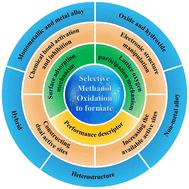当前位置:
X-MOL 学术
›
Catal. Sci. Technol.
›
论文详情
Our official English website, www.x-mol.net, welcomes your feedback! (Note: you will need to create a separate account there.)
Recent advances in selective methanol oxidation electrocatalysts for the co-production of hydrogen and value-added formate
Catalysis Science & Technology ( IF 4.4 ) Pub Date : 2024-08-27 , DOI: 10.1039/d4cy00727a Jiaxin Li 1 , Hongmei Yu 1 , Jingchen Na 1 , Senyuan Jia 1 , Yutong Zhao 1 , Kaiqiu Lv 1 , Wenzhuo Zhang 1 , Jun Chi 1 , Zhigang Shao 1
Catalysis Science & Technology ( IF 4.4 ) Pub Date : 2024-08-27 , DOI: 10.1039/d4cy00727a Jiaxin Li 1 , Hongmei Yu 1 , Jingchen Na 1 , Senyuan Jia 1 , Yutong Zhao 1 , Kaiqiu Lv 1 , Wenzhuo Zhang 1 , Jun Chi 1 , Zhigang Shao 1
Affiliation

|
Traditional water splitting is significantly impeded by the sluggish kinetics and large overpotential of the anodic oxygen evolution reaction (OER). Accordingly, replacing the OER with a more thermodynamically favorable organic substance oxidation reaction to combine with the hydrogen evolution reaction (HER) is an innovative strategy to obtain green hydrogen. In this case, the electro-reforming of methanol coupled with the electrochemical HER can realize the energy-saving co-generation of value-added formate and hydrogen. Therefore, controlling the process of methanol oxidation and making it selectively transform to formate have become a worthy topic. Thus far, various catalysts and modification strategies have been developed for the selective methanol oxidation reaction (SMOR). Transition metal-based materials are the most studied catalysts because their moderate catalytic ability can better control the process of methanol oxidation. Electronic structure modulation is the most efficient strategy to improve the SMOR performance of catalysts. However, few systematic reviews on the SMOR have been reported. In light of significant advances achieved recently, herein, we reviewed the recent advances in SMOR electrocatalysts for the co-production of value-added formate and green hydrogen. In particular, the mechanism of the SMOR is initially introduced, including the traditional surface adsorption mechanism and the newly developed lattice oxygen participation mechanism. Subsequently, strategies for catalyst design are analyzed from the aspects of chemical bond activation/inhibition, electronic structure manipulation, dual active site construction, and increasing the number of active sites. Thereafter, performance descriptors involving electrochemical measurements and product detection are discussed to show the basic evaluation criterion, and various catalysts for the SMOR are categorized according to their composition to display the development of catalysts. Finally, conclusions and perspectives are presented. We hope that this comprehensive effort will be helpful in the literature survey of the SMOR and provide inspiration to the SMOR research community, attracting more attention to the electro-upgradation of organic substances coupled with green hydrogen generation.
中文翻译:

甲醇选择性氧化联产氢气和高附加值甲酸盐电催化剂的最新进展
阳极析氧反应 (OER) 的缓慢动力学和大过电势严重阻碍了传统的水分解。因此,用热力学上更有利的有机物氧化反应代替OER,并与析氢反应(HER)相结合,是获得绿色氢气的创新策略。在这种情况下,甲醇电重整与电化学析氢技术相结合,可以实现高附加值甲酸和氢气的节能联产。因此,控制甲醇氧化过程并使其选择性地转化为甲酸盐已成为一个值得研究的课题。迄今为止,已经开发了用于选择性甲醇氧化反应(SMOR)的各种催化剂和改性策略。过渡金属基材料是研究最多的催化剂,因为它们适度的催化能力可以更好地控制甲醇氧化过程。电子结构调制是提高催化剂SMOR性能最有效的策略。然而,关于 SMOR 的系统评价却鲜有报道。鉴于最近取得的重大进展,我们在此回顾了用于联产增值甲酸盐和绿色氢气的 SMOR 电催化剂的最新进展。特别是,首次介绍了SMOR的机理,包括传统的表面吸附机制和新开发的晶格氧参与机制。随后,从化学键激活/抑制、电子结构操纵、双活性位点构建和增加活性位点数量等方面分析了催化剂设计策略。 此后,讨论了涉及电化学测量和产物检测的性能描述符,以展示基本的评价标准,并根据其组成对SMOR的各种催化剂进行分类,以展示催化剂的发展。最后提出结论和观点。我们希望这一综合努力能够对SMOR的文献调查有所帮助,并为SMOR研究界提供启发,吸引更多人对有机物质电升级与绿色制氢相结合的关注。
更新日期:2024-08-27
中文翻译:

甲醇选择性氧化联产氢气和高附加值甲酸盐电催化剂的最新进展
阳极析氧反应 (OER) 的缓慢动力学和大过电势严重阻碍了传统的水分解。因此,用热力学上更有利的有机物氧化反应代替OER,并与析氢反应(HER)相结合,是获得绿色氢气的创新策略。在这种情况下,甲醇电重整与电化学析氢技术相结合,可以实现高附加值甲酸和氢气的节能联产。因此,控制甲醇氧化过程并使其选择性地转化为甲酸盐已成为一个值得研究的课题。迄今为止,已经开发了用于选择性甲醇氧化反应(SMOR)的各种催化剂和改性策略。过渡金属基材料是研究最多的催化剂,因为它们适度的催化能力可以更好地控制甲醇氧化过程。电子结构调制是提高催化剂SMOR性能最有效的策略。然而,关于 SMOR 的系统评价却鲜有报道。鉴于最近取得的重大进展,我们在此回顾了用于联产增值甲酸盐和绿色氢气的 SMOR 电催化剂的最新进展。特别是,首次介绍了SMOR的机理,包括传统的表面吸附机制和新开发的晶格氧参与机制。随后,从化学键激活/抑制、电子结构操纵、双活性位点构建和增加活性位点数量等方面分析了催化剂设计策略。 此后,讨论了涉及电化学测量和产物检测的性能描述符,以展示基本的评价标准,并根据其组成对SMOR的各种催化剂进行分类,以展示催化剂的发展。最后提出结论和观点。我们希望这一综合努力能够对SMOR的文献调查有所帮助,并为SMOR研究界提供启发,吸引更多人对有机物质电升级与绿色制氢相结合的关注。





































 京公网安备 11010802027423号
京公网安备 11010802027423号